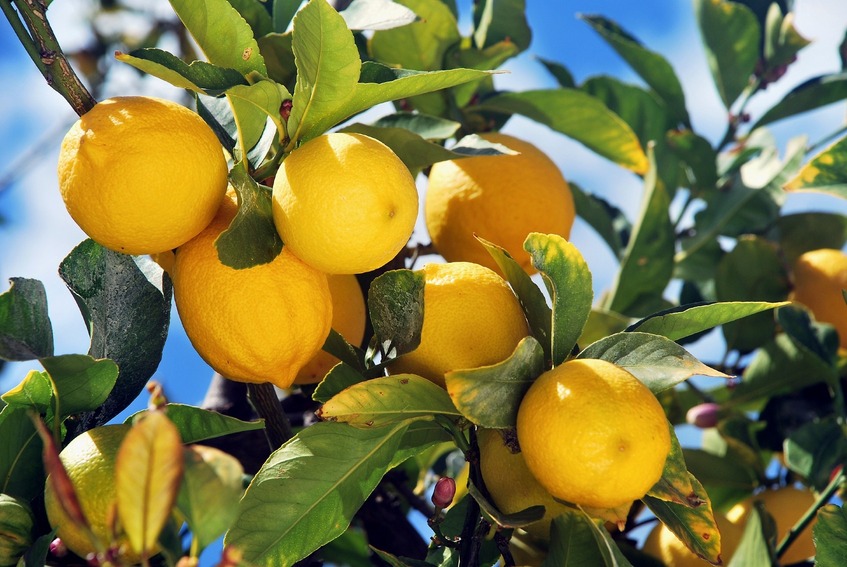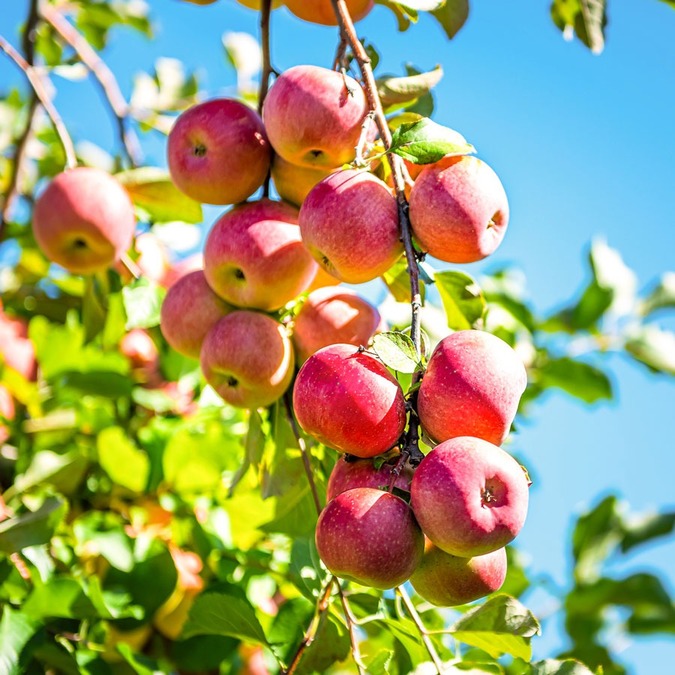Imagine stepping outside your door and picking fresh, ripe fruit right from your own garden or balcony. Growing your own fruit at home is not only a satisfying and healthy way to enjoy nature’s bounty, but it’s also surprisingly easy with the right choices. Whether you have a spacious yard, a compact patio, or even just a sunny windowsill, you can cultivate a variety of fruits that grow quickly and require minimal effort.
In this article, we’ll introduce you to 10 fast-growing fruits that you can easily nurture at home. These selections are perfect for gardeners of all skill levels, offering a combination of speed, simplicity, and sweet rewards. Start your journey to a homegrown harvest, and enjoy the taste of fresh fruit in no time!
1. Lemon

A lemon tree is a wonderful way to add some color to your patio or balcony. Depending on its size, the climate, and the age of the tree you buy, it can start producing fruit in the first year. Most grafted lemon varieties begin bearing fruit in the same year.
Make sure your lemon tree gets plenty of bright light, as it thrives on sunlight. Pick a spot that receives at least 8 hours of direct sunlight daily, whether indoors or outside. Sunshine is essential for the tree to flower and produce fruit. Water the tree deeply when the top two inches of soil feel dry, checking more frequently during the summer. Be careful not to overwater, as this can cause root rot.
Although lemon trees grow best in warmer regions, you can still enjoy them in colder climates by keeping them indoors during cooler weather and moving them outside in the summer.
2. Fig Tree

Fresh figs are a delicious, sweet treat that brings the taste of sunny places right to your garden. They’re worth the effort to grow, and their attractive, fragrant leaves add beauty to any space.
They grow quickly and can bear fruit as early as the first year if you choose a slightly mature variety. Many fig types are hardy enough to grow outdoors, and since they’re all self-fertile, you only need one tree to get a good crop.
The best time to plant a fig tree is in late winter or early spring, giving it plenty of time to establish before the cold weather arrives. Plant it in a deep hole, as fig trees have a long tap root. They flower in spring, and you can harvest ripe figs throughout the summer. If you want to control the tree’s height, consider growing a dwarf variety in a pot. Plant your figs in a warm, sheltered spot with full sun, and water them well. Once the fruits start developing, feed the tree with liquid tomato fertilizer every couple of weeks.
3. Strawberry

Strawberries are a fun crop to grow with your kids. They’re easy to grow in pots, window boxes, hanging baskets, grow bags, or strawberry planters, so even small gardens, balconies, or windowsills can accommodate them. They thrive in any climate, whether as an annual or perennial.
To harvest sweet, juicy fruits, grow your strawberry plants in a sheltered spot with plenty of sunlight. Before planting, mix in plenty of well-rotted horse manure or garden compost to enrich the soil. Water the plants well, especially during hot weather, and feed them regularly with a high-potash fertilizer starting in early spring.
Strawberries don’t like being planted in cold, wet soil, so it’s best to avoid winter or early spring planting if possible. The ideal time to plant potted strawberries is from late summer to early autumn, or in the spring.
4. Passion Fruit

Passion fruit is famous for its sweet, juicy seeds, but the plant also produces stunning flowers that add vibrant color to any garden and attract many butterflies. The fruit typically appears in 10-14 months, with a large harvest during the summer and fall. In tropical regions, the plant can produce fruit continuously.
This vine thrives in full sun, especially in cooler climates. In hotter areas, it might benefit from some shade during the hottest part of the day. It needs a warm, sheltered spot, particularly in cooler regions, and requires support for its tendrils to climb. It will cling to wires, fences, walls, or posts.
Make sure to water the plant well during flowering and fruit development. If the soil dries out while the fruit is forming, the plant may drop the fruit.
5. Watermelon

Watermelon is part of the cucurbit family, which includes pumpkins, squash, and zucchini. Like its relatives, most watermelon plants spread out as they grow, so they need a lot of space. However, there are smaller varieties that are great for limited spaces and can even be grown in large pots. If you’re looking for a fun plant that kids will enjoy, watermelon is a great choice!
They thrive in warm weather, so they need warm soil to start growing and good drainage is important. They need regular, deep watering to stay healthy and produce sweet, juicy fruit. Adding mulch around the plants helps keep the soil moist and keeps weeds at bay.
Depending on the type, watermelons can be ready to harvest in 60 to 100 days. Some of the fastest-growing varieties include Early Midget, Calsweet, Black Diamond, and Crimson Sweet.
6. Mulberry

There are mulberry varieties suited for all climates. The tree grows quickly, and if you plant a larger one, it may start producing fruit within a year or two. Grafted mulberry trees often begin flowering and fruiting in their first or second year. They ripen in the summer, producing sweet fruits.
Mulberries prefer well-drained, fertile soil and can handle most conditions except very wet soils. They are also drought and salt-tolerant, making them a good choice for urban or coastal areas. They grow best in full sun but can also tolerate some light shade. Mulberry trees grow quickly and don’t need much fertilizer.
To help the tree develop strong branches, prune it to remove narrow angles or crowded branches. Once the tree has a good shape, minimal pruning is needed.
7. Papaya

Papaya trees grow quickly, and a healthy plant can start producing fruit within 6 to 18 months after being planted.
They are usually grown from seeds. If planted in full sunlight, seedlings can sprout in about 2 weeks. They thrive best in full sun and well-drained soil. Since papayas have shallow roots, they don’t do well in wet conditions. The ideal spot to plant a papaya tree is on the south or southeast side of a house, where it gets protection from wind and cold.
Growing papaya trees is a rewarding way to enjoy these tropical fruits every year. To protect the developing fruit from pests, cover them with a paper bag until they ripen.
8. Banana
 Although often called a tree, the banana is actually an herbaceous plant because it doesn’t have a woody stem. Bananas grow rapidly in tropical and subtropical regions where the climate is hot and humid. Most banana varieties prefer full sun and thrive best in USDA Zones 9-11. Since they are tropical plants, bananas should be placed in the warmest part of your garden. They need at least 6 hours of sunlight each day, but 8-10 hours of full sun is ideal.
Although often called a tree, the banana is actually an herbaceous plant because it doesn’t have a woody stem. Bananas grow rapidly in tropical and subtropical regions where the climate is hot and humid. Most banana varieties prefer full sun and thrive best in USDA Zones 9-11. Since they are tropical plants, bananas should be placed in the warmest part of your garden. They need at least 6 hours of sunlight each day, but 8-10 hours of full sun is ideal.
Banana flowers usually start to appear around six months after planting. As the purple petals curl up and fall off, the bananas will begin to show. Hybrid banana plants grow quickly and produce fruit faster, while common varieties might take about a year to bear fruit. Bananas are truly fast-growing fruit plants.
You can grow a new banana plant by taking a banana rhizome, also known as a banana pup. To propagate new plants, simply separate the suckers from the parent plant and plant them.
9. Apple

You don’t need a lot of land to grow apple trees. Even in a small space, you can plant a hedge of dwarf apple trees or train an apple tree against a wall as an espalier and still get a good harvest. If you start an apple tree from a seed, it will take 6-10 years to produce fruit. But if you want faster results, you can buy a grafted apple tree that is at least 4 feet tall, and it will start bearing fruit in just 2 years.
Apple trees grow best in full sun, meaning they need at least six hours of direct sunlight daily in the summer. They prefer well-drained soil that can still hold some moisture. Light to medium-textured soils work best. Apple trees don’t do well in heavy clay soil because poor drainage can cause root rot.
10. Raspberry

Raspberries aren’t just delicious—they’re also packed with nutrients. They’re high in fiber and contain vitamin A, folate, antioxidants, and several minerals. The juice is rich in vitamin C, and the tiny seeds are a good source of vitamin E. Whether you enjoy fresh raspberries right off the plant, make raspberry jam, or freeze any extras, they’re a great addition to your diet.
Make sure to give raspberries enough space to grow. Pick a sunny spot with well-drained soil, mix in some compost to help them thrive, and prune them at the right time.
Because of their thorns, raspberries can also serve as a natural fence or barrier around your yard. If you don’t have enough space to plant them in the ground, consider growing smaller raspberry varieties in large containers.

